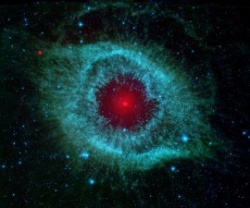When are you under Surveillance?
23. Sep. 2009
The history of surveillance is long, scary, and more topical than ever. It is presented in a special exhibition at Post & Tele Museum, where surveillance will practically be brought close to you.

Helix Nebula, also called the Eye of God. Helix Nebula is a dying star surrounded by dust and gas, 700 light years away from the earth, near the Aquarius constellation. Photographed by NASA’s infrared Spitzer telescope.
Dilemma
The centre of rotation of the exhibition - and of the history of surveillance - is a central dilemma: On one hand the state is supposed to guard our security and protect us against danger; on the other hand the state shall respect our democratic rights. The dilemma is not a new phenomenon, but it has become frighteningly topical in our global high-tech society where we are using communications as never before.
Our civic rights as written in the Danish Constitution are constantly challenged by anti-terrorism acts, anti-gang parcels, and campaigns against pirate copying and file sharing. The Constitution reads among other things: The home is inviolable. Domiciliary visits, confiscation, and examination of letters and other documents as well as violation of the secrecy of the mails, telegraph, and telephone can, where no law is authorizing a peculiar exception, only take place according to Court order (chapter VII, § 72).
The authorities have found it necessary to promulgate laws "authorizing a peculiar exception" to protect us against terrorists and criminals. But how far can the authorities go before they become as reckless as the people they are fighting? Where do you draw the line?
The Exhibition
The golden thread in the exhibition is five intense documentaries with concrete stories illustrating the human consequences of 400 years of surveillance. They present secret letter-opening during the absolute monarchy in Denmark (1660-1848), monitoring of the electric telegraph during World War I (1914-18), censorship and surveillance during World War II (1939-1945), eavesdropping scandals during the Cold War (1954-1991), and the present-day surveillance society where cameras on every street, mobile phones, and internet make it simple to monitor us in both private and public places.
In the exhibition you can see objects of significant importance to the Danish history of surveillance: the letter which the traitor Poul Juel tried to swallow in his attempt to avoid exposure; the pistol used for shooting prime minister Estrup; the surveillance equipment used by a Danish resistance group to listen in on the Gestapo in order to uncover informers and save resistance men; and the radio equipment used by the Danish navy to listen in on Russian war ships during the Cuban Missile Crisis which almost resulted in a third world war.
When are you under Surveillance?
It is registered which homepages you are visiting, which phone numbers you are calling, and where you are shopping with your credit card. You are filmed by CCTV cameras on the bus, on the train, and in the street.
The debate on surveillance is flaring up regularly in the Danish media. It may be difficult to navigate among the many innuendos, verbiage, and strange conspiracy theories. The exhibition at Post & Tele Museum provides no unfailing answers, but is asking critical questions giving you a perspective on the history of surveillance, as well as knowledge of your rights and Danish legislation.
The special exhibition "Surveillance" opened on the Night of Culture 9th October and can be seen until 24th October 2010.
See the exhibition trailer here
This article may be copied or quoted with MuseumsPosten, Post & Tele Museum as source.
Comment this article
Only serious and factual comments will be published.
Other comments for this article